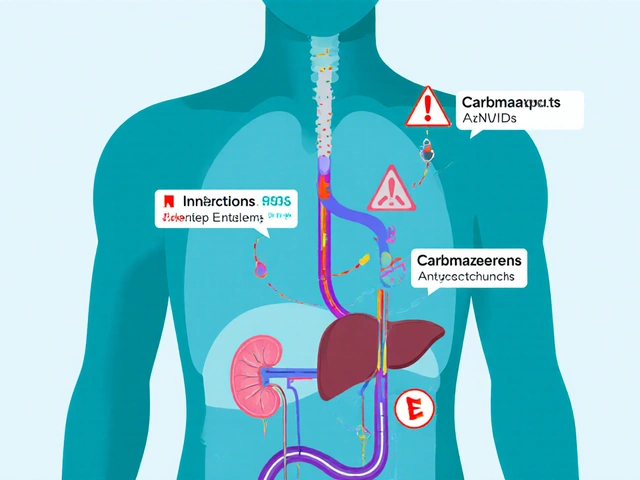There aren’t many names that pop up more than Zithromax when you’re running for a prescription to kick that nagging cough or sore throat. Parents swap stories about it at hockey practice, and doctors have handed out millions of these pink or blue tablets to both kids and adults. You might recognize it by its other name, azithromycin. It has a reputation for getting the job done fast, clearing up infections in a matter of days. But there’s more to this antibiotic than just the quick-fix hype—Zithromax is sort of the workhorse in the medicine cabinet, but you need to know the rules of the game before you take the plunge.
How Zithromax Works In Your Body
Most people see antibiotics as magic bullets—and, honestly, Zithromax comes pretty close sometimes. It belongs to a family called macrolides, which simply means it messes with bacteria by stopping them from making proteins they need to survive. Here’s the trick: while some antibiotics need to be taken several times a day, azithromycin sticks around in your system longer. That’s why docs often prescribe a once-daily dose, sometimes for just three to five days. You get the job done with fewer pills and, let’s face it, who really wants a 10-day course if you can do the same thing in half the time?
Zithromax is absorbed well, heading straight for the lungs, skin, tonsils—basically, all the places bacteria love to wreak havoc. This makes it a go-to for treating those nasty chest infections, sinus problems, and even some skin infections. One of the coolest parts is its „post-antibiotic effect”—Zithromax keeps working even after you finish the last pill. Maybe that’s why it’s so popular for things like bronchitis, pneumonia, and stubborn ear infections.
What’s wild is that the drug was originally invented in the ’80s in Croatia. Since then, it’s been on the World Health Organization’s List of Essential Medicines, which is a pretty good club to be in. In Canada, azithromycin isn’t just for humans—vets sometimes use it to treat infections in animals too. You’ll find it as tablets, capsules, or those sweet-flavored liquids that kids don’t gag on. The bottom line: it’s everywhere for a reason.
What Infections Does Zithromax Actually Treat?
This is where things get interesting, because people assume Zithromax works for every cough, sniffle, or sore throat. Not true. It’s only useful for bacterial infections—viruses like cold and flu are out. Doctors use it most commonly for:
- Strep throat and tonsillitis (although penicillin comes first, Zithromax gets used for those allergic to it)
- Community-acquired pneumonia and bronchitis
- Sinus and ear infections, especially when they’re hard to treat
- Some skin infections, like impetigo or cellulitis in kids (especially if they can’t swallow penicillin-type drugs)
- Sexually transmitted infections like chlamydia (usually a single big dose is enough!)
Emily, my daughter, once had a chest infection that would not quit—high fever, hacking cough, the works. Our pediatrician reached for the "Z-Pak,” that classic five-day course. She bounced back quick. That’s the reputation azithromycin has built: fast, reliable, kid-friendly.
But here’s the catch—using Zithromax when it’s not needed, like hammering away at a viral cold, is a recipe for disaster. That’s how bacterial resistance develops. Docs everywhere are begging folks to respect antibiotics, to avoid turning them into blunt instruments. Next time you’re hoping for a prescription, ask your doctor: Is this infection definitely bacterial? If not, skip the meds.

Common Side Effects And When To Worry
Zithromax has a pretty solid safety record, but it’s not all sunshine. The most common side effects aren’t too scary: mild diarrhea, tummy cramps, a bit of nausea. If you’ve ever taken a strong antibiotic, you know the drill. These symptoms usually fade fast, and can often be managed by taking the medicine with a bit of food. Hands down, Zithromax is easier on the gut than, say, amoxicillin-clavulanate, which can really turn your stomach inside out.
Now, here’s where you really need to pay attention. Rarely, Zithromax can mess with your heart rhythm (doctors call it „QT prolongation”), especially in folks who already have heart issues or are taking meds that interact. That’s why you’ll see warnings for people with a history of arrhythmias, or who already have low potassium or magnesium. Kidneys and livers do most of the work breaking down Zithromax, so if you’ve got trouble there, talk to your doc before starting any antibiotics. Some people, though not many, can get a nasty allergic reaction—think hives, swelling, or trouble breathing. That’s an ambulance call, not a „wait and see.”
A lot of parents worry about antibiotic resistance. It’s not just hype—it’s real. If you skip doses or stop taking Zithromax early because you „feel better,” leftover bacteria can mutiny, making the next infection harder to treat. Always finish the course, even if you’re already back at work or the kids are bouncing off the walls.
“The problem with antibiotics is not just overuse, but also not completing the prescribed course. That’s how resistance builds up—and it’s happening everywhere, not just in hospitals,” says Dr. Anna Banerjee, Toronto pediatric infectious disease specialist.
Bottom line: Take Zithromax exactly as directed, and call your doctor if something unusual happens. The magic is in using it right, not just grabbing it for every cough.
Tips For Taking Zithromax—What Most People Get Wrong
You’d think swallowing a pill or spoonful of syrup would be pretty straightforward, right? Yet even the most organized parents hustle at hockey and forget a dose, or folks chase pills with coffee or antacids. Here are simple things you can do to make sure Zithromax really works its magic:
- Take each dose with a full glass of water. None of this half-sip stuff. It helps the medicine absorb better and keeps your throat from feeling scratchy.
- If you miss a dose, take it as soon as you remember—unless it’s almost time for the next one. Then just skip and follow your schedule. Doubling up leads to stomach drama, not faster results.
- Watch what you eat! Calcium, magnesium, or aluminum (think dairy, antacids) can mess with absorption. Space them at least a couple hours apart from your dose.
- Don’t stop taking it just because you feel better. That last pill knocks out the toughest bacteria and keeps them from coming back stronger.
- If it’s liquid Zithromax, shake the bottle really well each time, and double-check the dose with a syringe or proper measuring spoon. Kitchen teaspoons are unreliable.
- Think about side effects. If you or your kid gets a new rash, trouble breathing, or swelling, get help fast. For diarrhea or upset tummy, probiotics and a bland diet can help.
And here’s a secret: you don’t need to refrigerate the liquid, but it can taste better cold. Kids often take it easier that way. Don’t sweat it if you have to stash it in a diaper bag when you’re traveling across town for the weekend.

The Problem With Antibiotic Resistance And Why It Matters
Here’s where things get scary. Zithromax is a zithromax keyword powerhouse, but overusing it is like crying wolf: Pretty soon, the medicine just won’t work on the bugs that matter. We’re seeing this play out with some nasty bacteria—one day, the old reliable Z-Pak could be useless for simple stuff like ear infections or pneumonia. Why? Because every unnecessary dose teaches bacteria how to survive the attack, passing those survival tips along to the next generation of germs.
Across Canada, health officials have been tracking resistance rates, and while we still use Zithromax all the time, guidelines are shifting. Docs don’t just hand it out for every sniffle, cough, or sore throat. For things like a simple runny nose, there’s zero benefit—it only increases the risk that, when you really need an antibiotic, it won’t work. Hospitals are getting stricter about what infections should be tackled by azithromycin. The more the public can help by following prescription advice, the longer we get to keep this tool at our disposal.
If you’re raising kids like I am, it’s tempting to ask for „just in case” antibiotics when the school nurse calls about a sore throat. Most of the time, you’ll be sent home with advice to rest, hydrate, and wait it out. Don’t push your doctor for Zithromax unless tests show it’s a true bacterial infection. Being cautious now means you’ll have options later when you or your kid really needs them.
Here’s something else to chew on: resistance doesn’t just risk your own health. It threatens everyone in your family and even your neighborhood, since bacteria travel way faster than most people realize. The World Health Organization has gone so far as to call antibiotic resistance one of the top health threats of the 21st century—not just medical scare tactics, but solid science.
So next time you hear Zithromax mentioned, remember it’s still one of the stars in the pharmacy lineup. The more respect you give it, the longer it’ll stick around to help your family and mine.









Aaron Miller June 14, 2025
Zithromax hype is nothing more than a marketing circus!!! Doctors love the quick‑fix narrative, but the reality is far messier; patients get a pink pill and think they’re invincible-spoiler: they’re not!!! Overprescribing fuels resistance, and the so‑called “once‑daily miracle” masks the fact that you’re still dumping antibiotics into the environment!!!
Roshin Ramakrishnan June 15, 2025
Friends, let’s remember that antibiotics like azithromycin are valuable tools-when used correctly they can save lives, and when misused they can create problems; always finish the prescribed course, and never take them for viral colds, because viruses won’t listen to our prescriptions, no matter how persuasive we feel!
Todd Peeples June 16, 2025
From a pharmacokinetic perspective, azithromycin exhibits a prolonged tissue half‑life, enabling sustained therapeutic concentrations beyond plasma elimination; this post‑antibiotic effect justifies the abbreviated dosing regimens commonly employed in clinical practice. Moreover, the drug’s extensive intracellular penetration underpins its efficacy against atypical pathogens. 😊📚
Chris Smith June 17, 2025
Oh great, another “miracle pill” hype train.
Leonard Greenhall June 19, 2025
Actually, the statement oversimplifies a nuanced therapeutic class; azithromycin belongs to macrolides, each with distinct spectrum and resistance profiles, so blanket dismissals are scientifically inaccurate.
Abigail Brown June 20, 2025
When I was a kid, my mother would line up the medicine cabinet like a tiny pharmacy, each bottle labeled in her neat script, and the pink Z‑Pak always sat at eye level, beckoning like a promise of rapid recovery. The first time I swallowed those tablets I felt an almost cinematic surge of confidence, as if I’d conquered a bacterial foe with a single, elegant swipe. Over the years, I’ve watched friends and family ride the wave of quick symptom relief, only to later discover lingering fatigue that no antibiotic could have prevented. The allure of a short three‑day course is understandable; modern life rewards speed and convenience above all else. Yet, each dose carries a microscopic battlefield, where resistant strains can emerge if the pathogen isn’t fully eradicated. Studies have shown that sub‑therapeutic exposure selects for mutations that render macrolides ineffective, a trend that is creeping into community‑acquired infections. In a world where we already wrestle with multi‑drug‑resistant tuberculosis, the stakes of careless azithromycin use become even higher. Parents, especially, must weigh the immediate comfort against the long‑term public health implications, because each unnecessary prescription adds weight to the resistance burden. Moreover, the drug’s interaction profile is not trivial; QT prolongation, though rare, can precipitate life‑threatening arrhythmias in susceptible individuals. The liver and kidneys, our natural detoxifiers, must metabolize each pill, and patients with hepatic or renal impairment may experience accumulation and toxicity. Pediatric dosing, while often flavored to coax children, still demands precise measurement; a kitchen teaspoon is a recipe for under‑dosing or overdosing. On the flip side, when prescribed appropriately, azithromycin’s post‑antibiotic effect can reduce bacterial regrowth, shortening recovery time and decreasing overall antibiotic exposure. That is why guidelines emphasize culture‑directed therapy whenever feasible. In practice, however, the convenience of a “just in case” prescription often outweighs the rigor of diagnostic stewardship. Finally, education remains our most potent weapon: empowering patients with knowledge about when antibiotics truly help can preserve their efficacy for future generations.
Crystal Slininger June 21, 2025
It’s worth noting that the pharmaceutical industry has a vested interest in keeping Z‑Pak on the shelf; aggressive marketing campaigns often downplay resistance data, and some clinicians receive incentives that subtly bias prescribing habits-an issue that the public should be vigilant about.
Sumeet Kumar June 22, 2025
Hey everyone, just a friendly reminder that staying hydrated and getting plenty of rest are the first lines of defense; antibiotics are like a backup squad, not the main quarterback, so let your body do its part before calling in the pros.
Maribeth Cory June 23, 2025
Absolutely, supporting the immune system with nutrition and sleep can reduce the need for unnecessary antibiotics, and when a prescription is given, adhering to the exact schedule maximizes its effectiveness.
andrea mascarenas June 24, 2025
Great points made above; consistency in dosing is key.
Vince D June 26, 2025
Yep, stick to the plan.
Camille Ramsey June 27, 2025
Dont let the hype of a “magic bullet” blind you from the complex truth about microbial ecology; overuse mangles the delicate balance and leaves us vulnerable.
Scott Swanson June 28, 2025
Sure thing, because who needs nuance when we can just shout about resistance and expect everyone to quit the drug tomorrow?
Karen Gizelle June 29, 2025
Honestly, the way some people cavalierly demand antibiotics for any sniffle is downright irresponsible. We have a duty to future generations to preserve these medicines, and that starts with thoughtful conversations, not impulsive requests. The data definitly shows that stewardship saves lives, and it’s high time we all act like responsible adults.